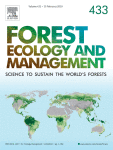Ver ítem
- xmlui.general.dspace_homeCentros Regionales y EEAsCentro Regional Patagonia NorteEEA BarilocheArtículos científicosxmlui.ArtifactBrowser.ItemViewer.trail
- Inicio
- Centros Regionales y EEAs
- Centro Regional Patagonia Norte
- EEA Bariloche
- Artículos científicos
- Ver ítem
Droughts drive outbreak dynamics of an invasive forest insect on an exotic host
Resumen
Insect outbreaks are among the most important biotic disturbances in forest ecosystems and can exert immense economic and ecological impacts. Understanding the spatio-temporal patterns of eruptive insects can provide insights into the mechanisms driving their dynamics and help predict future responses under climate change. The aims of this study were to analyze the spatio-temporal patterns of outbreaks of the woodwasp Sirex noctilio –a major invasive pest
[ver mas...]
Insect outbreaks are among the most important biotic disturbances in forest ecosystems and can exert immense economic and ecological impacts. Understanding the spatio-temporal patterns of eruptive insects can provide insights into the mechanisms driving their dynamics and help predict future responses under climate change. The aims of this study were to analyze the spatio-temporal patterns of outbreaks of the woodwasp Sirex noctilio –a major invasive pest of pines– in an invaded region of South America, to assess the relative importance of density-dependent and density-independent mechanisms on population dynamics, and to identify the primary factors that influence the magnitude of outbreaks. We used tree ring and insect sampling data of more than 1000 trees to reconstruct S. noctilio outbreaks in 29 pine stands across Patagonia-Argentina over a 16-year period. We found marked spatial synchrony in S. noctilio outbreaks at a regional scale. Rates of tree mortality from S. noctilio were influenced by both density-dependent and density-independent factors. The occurrence of S. noctilio outbreaks are triggered by an abrupt increase in drought, which likely increases the availability of susceptible host trees. The damage caused by the outbreaks is determined by stand level variables, closely related with tree stress. Rates of tree mortality decreased over time due to negative density-dependence in S. noctilio populations, likely due to the loss of suitable resources over time. Depicting mechanisms of large-scale tree mortality in ecosystems
provides insights to the drivers of forest outbreaks and other factors such as responses to a changing climate.
[Cerrar]

Autor
Lantschner, Maria Victoria;
Aukema, Brian H.;
Corley, Juan Carlos;
Fuente
Forest Ecology and Management 433 : 762-770. (February 2019)
Fecha
2019-02
Editorial
Elsevier
ISSN
0378-1127
Formato
pdf
Tipo de documento
artículo
Palabras Claves
Derechos de acceso
Restringido
 Excepto donde se diga explicitamente, este item se publica bajo la siguiente descripción: Creative Commons Attribution-NonCommercial-ShareAlike 2.5 Unported (CC BY-NC-SA 2.5)
Excepto donde se diga explicitamente, este item se publica bajo la siguiente descripción: Creative Commons Attribution-NonCommercial-ShareAlike 2.5 Unported (CC BY-NC-SA 2.5)

